Gardening With Intention
By Trish Beckjord
Although I’ve been writing more about bees recently, I find I still don’t know them very well. Fortunately, my reading has at least made me more comfortable with having these little critters around so when I was visiting the Kane County Master Gardeners Idea Garden yesterday and found a small bee sitting on my arm, I took it as an opportunity to take a closer look.
A small sweat bee I thought (Halictus?), feeling proud of myself for even thinking of it. It made me feel good that he/she found me approachable, and I felt I could welcome him though I wish I’d had a bee expert next to me with a ready answer as to what species it was!
Having this experience helps me see how far I’ve come in my own gardening practices and how much I’ve learned about how to garden for pollinators. Said differently, I am gardening for diversity with pollinators as my end goal; I am gardening with intention.
Speaking of intention, Lori Weidenhammer’s Victory Gardens for Bees suggests thinking of your entire yard as a “Bee and Bee” for native bees. This helpful book includes a slightly intimidating list of 16 rules for bee-safe gardens and five additional housing strategies for pollinators. While the original text is worth reading, I’ve tried to hone this information down to a more manageable list of 10.
- Bees prefer sunny gardens that receive at least 6 hours of light although if you are blessed with a shade garden all is not lost! Blue Orchard Mason Bees and Bumblebees will be active in shade gardens. Native plants such Wild Columbine, Woodland Phlox, Dutchman’s Breeches, Violets (there are a number of natives), Wild Geranium and our native Wild Stonecrop are all good choices for the shade garden.
- I don’t think there are just some native plants you need to include if you want to support our native bees. Just concentrate on adding a variety of species and choose native plants that will provide a succession of blooms and a variety of flower types through the season (March/April – October). More floral diversity encourages supporting more pollinator species including native bees. Re-read last month’s Sustainability Tip.
- Long-tongued bees prefer flowers with deeper nectar cups such as Foxglove Beardtongue or Woodland Phlox vs. those that are shallower such as Lanceleaf Coreopsis. A variety of flower shapes will attract and support a variety of bees and other pollinators. Also aim to include flowers that are rich producers of nectar and/or pollen rather than species that are merely ornamental and that only you find attractive.
- Be aware that nectar-producing plants require a good water source to produce good supplies of this important bee (and other pollinator) food. And, it turns out, short-tongued bees are more sensitive to nectar shortages in dry periods because their tongues are not long enough to reach lower nectar levels in the flowers. The Victory Garden For Bees recommends creating a bee “re-hydration station” – a dish of clean water with rocks, branches and even moss for bees and other pollinators to perch on to drink. Just putting some small rocks in my shallow bird bath drew them in. I was surprised that I’d not thought of this need before!
- Pick the barest, worst part of your lawn and designate it as a spot for ground nesting bees. Try to pick a couple of places in your yard that offer slightly different conditions that might be attractive to different species. It turns out 70% of native bees are ground nesters. To protect these species, avoid or minimize the amount of soil tilling and digging you do in the garden and be aware of – and avoid disturbing – possible bee nesting sites.
- Just as a B&B supplies sheets, pillows and towels, supply different nesting materials. Options include wood, leaves that are smooth on one side and not too thin or thick, wet mud, pine logs and plant species that produce an important chemical for some bees called Linalool. To provide this you need to include plants such as Monarda or herbs such as cilantro or basil. Lavender is a good source too. Each of these materials supports different species.
- Remember the Beetle Bump I wrote about last February? Well, it turns out this pile of decomposing wood in a shady location in your garden also attracts butterflies and bees. Pile on some leaves/leaf mulch and it will be a perfect home for overwintering queen bumblebees and moths and butterflies that overwinter in their chrysalis form. Tunneling bees also like drilled holes in rotting wood. Holes that are < a quarter inch in diameter should be drilled about 3-5” deep. Larger holes (wider than ¼”), should be 5-6” deep.
- Hollow stems in herbaceous species and small woody stems add another type of nesting material. Provide these for those bee species that hollow out twigs and create tunnels to lay eggs. There are many versions of bee houses on the market today, that offer this ready-made but you can create one by just keeping plant stems standing in your garden over the winter. Many of us leave the whole plant standing, but you can also give the dead stems a “stubble” cut to about a foot high.
- While you may prefer to use weed cloth barriers and lots of mulch in your gardens these practices are not good for either perennial gardens or our native ground-nesting bees which are smothered by these practices. Use a natural leaf-based mulch rather than wood chips and apply it only 1-1 ½” deep. Don’t use dyed materials.
- Stay away from pesticides, particularly those classified as neonicotinoids (see Sustainability Tidbit reprinted this month from Nov. 2017). Bees suffer from direct exposure by spraying and also indirectly by coming into contact with contaminated nectar and pollen. As reported in the Victory Garden for Bees, neonicotinoids – or neonics as they are called – are 5-10,000 times more toxic than DDT. Make sure you are buying plants from a reputable supplier that can tell you whether the plants have been treated with neonics and stay away. Remember, neonics aren’t the only problem though. Mosquito-killing sprays are non-specific and negatively affect our bees and other pollinators too as does treating our lawns for grubs.
I hope these “Rules to Live By” for the garden help guide your decisions and choices and reinforce some of your past positive actions. I’ll close by sharing a blog post I found from Mandi Ehman about how to live intentionally. I think it is helpful to think about this in relation to our gardening practices.
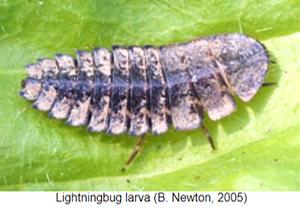
If you saw this guy you might think you have a serious infestation of something BAD! But be careful! It’s a firefly larvae. These beneficial guys feed on small insects, worms, slugs, and snails. They live primarily in the thatch layer in lawns and other damp locations close to the soil. 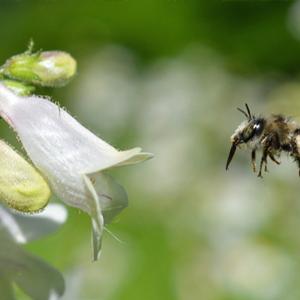
Long-tongued Digger Bee approaching Beardtongue Photo: Native Beeology 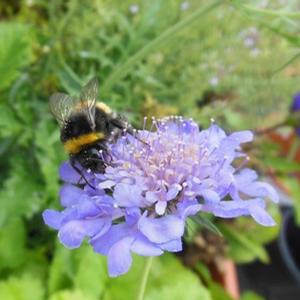
A shorter-tongued buff-tailed bumblebee on this Scabiosa. See full blog post in Resources. Photo: Bee Safe 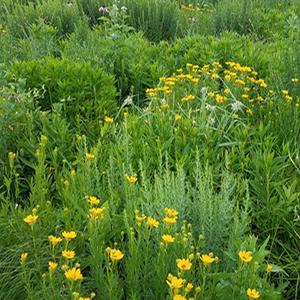
Although everything is not in bloom now, this garden clearly provides a diversity of species and flower shape. Photo: TBeckjord 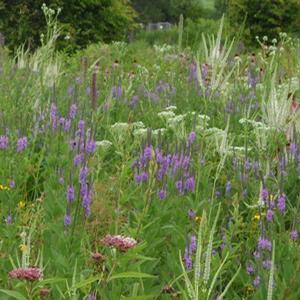
As does this…. Photo: TBeckjord 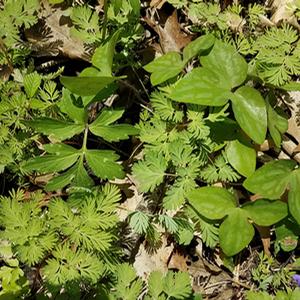
Species variety in a spring shade garden is also important. Photo: TBeckjord 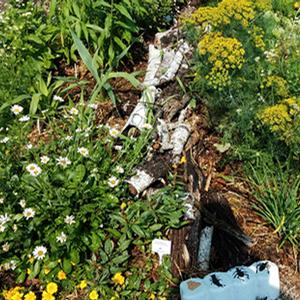
A modified “Beetle Bump” in the Kane County Master Gardeners Idea Garden! Photo: T.Beckjord
Resources
Floral Ecology: The Flower Tells You What Pollinator To Expect. From Bee Safe.
The Buzz on Bees: True or False. From Pollinator Partnership.
Victory Gardens for Bees: a DIY Guide to Saving the Bees. Weidenhammer, Lori. Douglas and McIntyre Ltd. 2016.
Back To Blog
